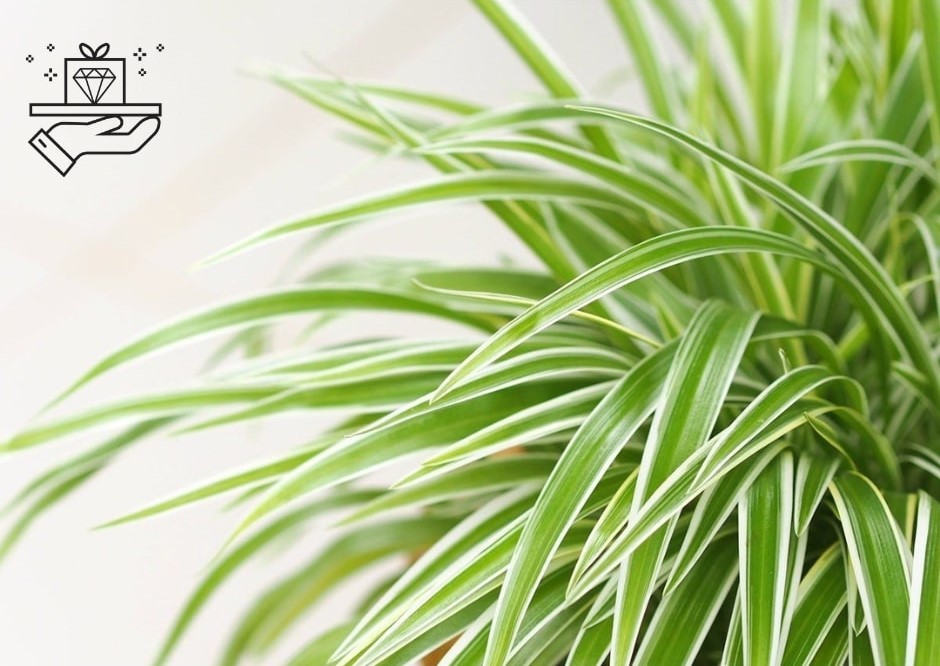Spider plants are among the most popular plants to grow indoors and gift to family and friends. Aside from being resilient and easy to grow, these plants have vibrant green leaves and air purification abilities.
In this article, we will explore different spider plant varieties and explain everything you need to know about their features. We will also give you tips on how to care for these remarkable plants.
Zebra Grass Spider Plant


Botanical Name: Chlorophytum laxum ‘Zebra’
Origin: Africa
Size: Typically grows up to 12 inches in height
Light: Thrives in bright, indirect light but can tolerate lower light conditions
Water: Allow the top inch of soil to dry between waterings, and water moderately
Toxicity: Non-toxic
The zebra grass spider plant is a tropical African native perennial known for its tightly clustered yellow-cream leaves with a prominent green stripe down the center.
They typically reach a height of 8 to 12 inches and a width of 18 to 24 inches when fully grown. This versatile plant can thrive indoors, in pots or hanging baskets, and in outdoor backyard gardens.
Zebra grass spider plants are relatively low-maintenance and require only partial to full sunlight and regular watering. They can even tolerate lower light conditions and occasional lapses in watering without losing their visual appeal.
They thrive in well-draining, peat-based soil, moderate to high humidity levels, and temperatures between 65°F and 75°F.
Zebra grass spider plants are prolific propagators; they produce numerous baby plants from the ends of their stems.
Best for: Since the zebra grass spider plant produces baby plants, it can be a great option for people who want to increase their collection of spider plants.
Airplane Spider Plant


Botanical Name: Chlorophytum comosum ‘Variegatum’
Origin: South Africa
Size: Typically reaches a height of 12–15 inches
Light: Prefers bright, indirect light but can tolerate some shade
Water: Once a week
Toxicity: Non-toxic
The airplane spider plant has green leaves that are gracefully curved with delicate white margins. It can reach an impressive indoor height of up to 24 inches.
A closer look reveals intricate lime and dark green streaks running through the center of its foliage, which is why it’s also called the “reverse variegated spider plant.”
The airplane spider plant thrives with partial sunlight and a weekly watering routine. While it can tolerate lower light conditions, it thrives and maintains its leaf health best when provided with bright, indirect light.
Their soil should be well-draining, slightly moist, and loam-based, and they thrive in moderate to high humidity conditions. Keeping the temperature between 70°F and 90°F will also ensure their optimal growth and overall health.
Best for: The airplane spider plant is easy to care for, which makes it ideal for beginners who can only water their plants once a week.
Bonnie Curly Spider Plant


Botanical Name: Chlorophytum comosum ‘Bonnie’
Origin: South Africa
Size: Typically grows up to 10–12 inches in height
Light: Thrives in moderate to bright indirect light
Water: Around once or twice a week
Toxicity: Non-toxic
The bonnie spider plant is known for its long and wide leaves adorned with alternating green and white stripes that create an elegant twist and curl. This unique characteristic earns it the nickname “curly spider plant.”
The bonnie spider plant is relatively compact and reaches a modest height of 6 to 8 inches when cultivated indoors.
This plant thrives in locations with plenty of partial to full sunlight, which makes it ideal near east or south-facing windows.
While it can tolerate up to 2 to 3 hours of bright sun, it’s important to avoid excessive exposure, as prolonged sunlight can result in scorched leaves. It grows best in a warm environment and with moist, well-draining soil.
Water around once or twice a week, and ensure that the topsoil has dried out between waterings.
Best for: The bonnie spider plant is ideal for adding a unique twist to interiors, especially in compact spaces, and is suitable for beginner gardeners.
Bichetii Grass Spider Plant


Botanical Name: Chlorophytum laxum ‘Bichetii’
Origin: Asia, Africa, and Australia
Size: Typically grows to a height of 12–18 inches
Light: Prefers bright, indirect light but can tolerate lower light conditions
Water: Maintain a steady level of soil moisture while preventing excessive water accumulation
Toxicity: Non-toxic
Originating in Asia, Africa, and Australia, the Bichetii grass spider plant is a common sub-variety of the Chlorophytum laxum. Its features include arching narrow grass-like leaves with cream-white margins.
While some spider plant varieties produce baby plants, the Bichetii grass does not produce additional offshoots.
It thrives in lighting conditions ranging from full sun to partial shade and prefers well-draining soil with moderate watering.
Best for: The Bichetii grass spider plant is best for beginners and gardeners just starting out, as it’s a low-maintenance plant that thrives in various indoor settings.
Vittatum Spider Plant


Botanical Name: Chlorophytum comosum ‘Vittatum’
Origin: West and South Africa
Size: Typically grows to a height of 12–24 inches
Light: Thrives in moderate to bright indirect light
Water: Around once a week
Toxicity: Non-toxic
The Vittatum spider plant, scientifically known as Chlorophytum comosum ‘Vittatum,’ originates from Southern and Western Africa. This plant showcases long, slender leaves with a prominent yellow band running down the center.
With a maximum height and spread of 24 inches, the Vittatum spider plant is suitable for border planting and garden beds. It thrives in partial sun but also tolerates various light conditions, including some direct sun exposure, partial shade, and even lower-lit areas.
The Vittatum spider plant can endure cooler temperatures ranging from 55°F to 75°F.
During its active growing season from early spring to fall, it benefits from regular watering, typically once a week.
However, it’s essential to reduce both watering and fertilization during the winter months to accommodate its natural growth cycle.
Best for: The Vittatum spider plant is ideal for those who want a classic spider plant look in their indoor space.
Variegated Bonnie Spider Plant


Botanical Name: Chlorophytum comosum ‘Bonnie Variegated’
Origin: South Africa
Size: Typically reaches a height of 8 inches
Light: Prefers bright, indirect light but can tolerate lower light levels
Water: Maintain slightly moist soil, avoiding both drought and waterlogging
Toxicity: Non-toxic
The variegated bonnie spider plant is a captivating curly variety featuring variegated leaves. These long and slender leaves feature green stripes along the edges and a cream stripe down the center.
This spider plant reaches a modest height of around eight inches. It can be an attractive focal point in indoor environments and add a touch of elegance to its surroundings.
To ensure the optimal growth of the variegated bonnie spider plant, provide it with bright, indirect light. Use well-draining soil that remains slightly moist and maintain moderate to high humidity levels.
Ocean Spider Plant


Botanical Name: Chlorophytum comosum ‘Ocean’
Origin: South Africa
Size: Typically grows to a height of 12–18 inches
Light: Thrives in moderate to bright indirect light
Water: Allow the top inch of soil to dry between waterings
Toxicity: Non-toxic
The ocean spider plant, scientifically known as Chlorophytum comosum ‘Ocean,’ is a compact and variegated member of the spider plant family. It has short and spiky leaves that are elegantly bordered in cream-white.
This spider plant is native to the warm and humid coastal regions of South Africa. It thrives in partial sun or shade with a preference for a soil environment that is damp but well-draining.
When cultivated as a houseplant, the ocean spider plant typically reaches a height of up to 18 inches. Its clean and compact form makes it a popular choice for placement in hanging baskets and confined spots in both indoor and outdoor settings.
During warm summers, the ocean spider plant can produce star-shaped white flowers and new baby plants from its long stems.
Maintaining ambient temperatures around 60°F is ideal for it to thrive and retain its captivating appearance.
Best for: The ocean spider plant is ideal for those who have limited area for plants since this variety only takes up little space.
Hawaiian Spider Plant


Botanical Name: Chlorophytum viridescens ‘Hawaiian’
Origin: South Africa
Size: Typically reaches a height of 6–12 inches
Light: Prefers moderate to bright indirect light
Water: Keep the soil consistently moist
Toxicity: Non-toxic
The Hawaiian spider plant, also known as Golden Glow or Golden Light, has a striking yellow hue that runs down the center of its leaves. While smaller than other Chlorophytum comosum varieties, this hybrid plant produces many plantlets.
The Hawaiian spider plant is a low-maintenance houseplant that can reach heights ranging from 6 to 12 inches. It loves environments with bright, indirect light, maintained well-draining and slightly moist soil, and moderate to high humidity levels.
While this spider plant can handle lower temperatures, it’s important to note that this may affect its growth. So, maintaining temperatures between 70°F and 90°F is ideal for its optimal development and visual appeal.
Best for: The Hawaiian spider plant is an excellent choice for those who are looking to adorn their homes with multiple spider plants due to its propensity to create new plants.
Green Spider Plant


Botanical Name: Chlorophytum comosum ‘Solid Green’
Origin: South Africa
Size: Typically grows up to 12–24 inches in height
Light: Tolerates low to bright indirect light conditions
Water: Around once a week
Toxicity: Non-toxic
The green spider plant, scientifically known as Chlorophytum comosum ‘Solid Green,’ has stems and leaves that are a uniform, pure green color.
This sought-after variety tends to be rarer and more expensive than the other spider plant varieties.
As a houseplant, the green spider plant can grow lush and large, reaching a mature height of up to 24 inches. Whether placed in garden beds, on shelves, in pots, or in hanging baskets, this spider plant adapts effortlessly to various indoor environments.
It can thrive with less light, although it still requires partial sunlight for optimal growth. When it comes to watering, a routine of once a week suffices, provided that the soil is allowed to dry out between waterings.
Overwatering should be avoided to prevent the risk of root rot, and consider repotting the green spider plant every one to two years.
Best for: The green spider plant is best for those seeking traditional greenery for indoor gardens and is perfect for beginners.
Fire Flash Spider Plant


Botanical Name: Chlorophytum amaniense ‘Fire Flash’
Origin: South and West Africa
Size: Up to 12 inches
Light: Prefers bright, indirect light
Water: Keep the soil consistently moist but not waterlogged
Toxicity: Non-toxic
The fire flash spider plant has wavy, lance-shaped dark green leaves elegantly supported by orange stems.
While this plant can produce small white flowers in loose clusters during summer, these blooms have a short lifespan, lasting only about a week.
As one of the smaller spider plant species, the fire flash spider plant reaches a maximum height and spread of around 12 inches when cultivated as an indoor plant.
It’s important to shield this variety from direct afternoon sun, as excessive heat can lead to leaf scorching and browning.
The fire flash spider plant has sturdy and thick roots. This enables it to store water effectively, but it needs weekly deep watering to ensure the soil remains moist.
Regular misting in summer months is also important to help prevent excessive drying
Best for: The fire flash spider plant is ideal for people who want unique, colorful leaves for a tropical look.




